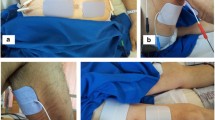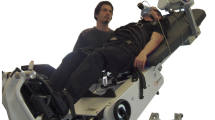Abstract
The purpose of this study was to develop a biofeedback tilt-table for automatic tilt-table training, helping patients with spinal cord injury (SCI) to recover more rapidly from orthostatic hypotension, and increasing safety to avoid syncope during training. This biofeedback tilt-table implemented automatic training maneuvers and included three closed feedback loops to monitor the acquisition of physiological signals from patients and the feedback of presyncope symptoms (PS) to regulate the angle of tilt. The results of clinical testing revealed that the mean blood pressure and oxygen saturation represented the most useful physiological signals for determining PS feedback and the quantitative criteria adopted were practicable and useful in describing the level of PS. This novel biofeedback tilt-table system offered higher patient throughput, faster training and safety in training of SCI patients to overcome their orthostatic hypotension than traditional tilt-table training, and could provide quantitative information of PS to assist medical staff in studying the mechanism of orthostatic syncope.



Similar content being viewed by others
References
American Autonomic Society and American Academy of Neurology (1996) Consensus statement on the definition of orthostatic hypotension, pure autonomic failure and multiple system atrophy. Neurology 46:1470
Applegate WB, Davis BR, Black HR, Smith WM, Miller ST, Burlando AJ (1991) Prevalence of postural hypotension at baseline in the systolic hypertension in the elderly program (SHEP) cohort. J Am Geriatr Soc 39:1057–1064
Chao CY, Cheing GL (2005) The effects of lower-extremity functiona electric stimulation on the orthostatic response of people with tetraplegia. Arch Phys Med Rehabil 86:1427–1433
Engel P, Hildebrandt G (1976) Long-term studies about orthostatic training after high spinal cord injury. Paraplegia 14:159–164
Gonzalez F, Chang JY, Banovac K, Messina D, Martinez-Arizala A, Kelley RE (1991) Autoregulation of cerebral blood flow in patients with orthostatic hypotension after spinal cord injury. Paraplegia 29:1–7
Houtman S, Colier WNJM, Oeseburg B, Hopman MTE (2000) Systemic circulation and cerbral oxygenation during head-up tilt in spinal cord injured individuals. Spinal Cord 38:158–163
Illman A, Stiller K, Williams M (2000) The prevalence of orthostatic hypotension during physiotherapy treatment in patients with an acute spinal cord injury. Spinal Cord 38:741–747
Lipsitz LA (1989) Orthostatic hypotension in the elderly. N Engl J Med 321:952–957
Mukai S, Hayano J (1995) Heart rate and blood pressure variabilities during graded head-up tilt. J Appl Physiol 78:212–216
Onrot J, Goldberg MR, Hollister AS (1986) Management of chronic orthostatic hypotension. Am J Med 80:454–464
Paul S, Zygmunt D, Haile V (1988) Chronic orthostatic hypotension. Compr Ther 14:58–65
Rutan GH, Hermanson B, Bild DE, Kittner SJ, LaBaw F, Tell GS (1992) Orthostatic hypotension in older adults: the cardiovascular health study. CHS collaborative research group. Hypertension 19:508–519
Sampson EE, Burnham RS, Andrews BJ (2000) Function electrical stimulation effect on orthostatic hypotension after spinal cord injury. Arch Phys Med Rehabil 81:139–143
Schatz IJ (1984) Orthostatic hypotension. I. Functional and neurogenic causes. Arch Intern Med 144:773–777
Veerman DP, Imholz BPM, Wieling W, Karemaker JM, van Montfrans GA (1994) Effects of aging on blood pressure variability in resting conditions. Hypertension 24:120–130
Wall BM, Runyan KR, Williams HH, Bobal MA, Crofton JT, Share L, Cooke CR (1994) Characteristics of vasopressin release during controlled reduction in arterial pressure. J Lab Clin Med 124:554–563
Author information
Authors and Affiliations
Corresponding author
Rights and permissions
About this article
Cite this article
Liu, D.S., Chang, W.H., Wong, A.M.K. et al. Development of a biofeedback tilt-table for investigating orthostatic syncope in patients with spinal cord injury. Med Bio Eng Comput 45, 1223–1228 (2007). https://doi.org/10.1007/s11517-007-0272-0
Received:
Accepted:
Published:
Issue Date:
DOI: https://doi.org/10.1007/s11517-007-0272-0




